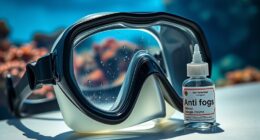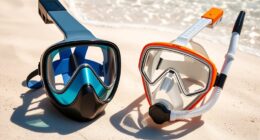When snorkeling in cold water, you need proper thermal protection like wetsuits or drysuits to prevent hypothermia. Use hoods, gloves, and booties to keep warm, and always check weather conditions before heading out. Snorkeling with a buddy enhances safety, so make sure to discuss plans and use a dive flag to signal your presence. Take caution entering the water to avoid cold shock. If you want to learn more about specific techniques and gear, keep exploring!
Key Takeaways
- Select appropriate thermal protection gear, such as wetsuits (3mm to 7mm) or drysuits, based on water temperature to prevent hypothermia.
- Use accessories like hoods, gloves, and booties to enhance warmth and protect extremities during cold water snorkeling.
- Gradually acclimate to cold water by entering slowly and practicing controlled breathing to reduce shock and anxiety.
- Always snorkel with a buddy, communicate plans clearly, and use a dive flag to ensure safety in potentially hazardous conditions.
- Stay alert to your body’s signals, avoid overexertion, and hydrate regularly to maintain comfort and safety during your snorkeling session.

Have you ever wondered what it’s like to explore the underwater world in chilly waters? Snorkeling in cold water can be an exhilarating experience, but it comes with its own set of challenges. To make the most of your adventure, you’ll need to prepare adequately, focusing on gear and techniques that guarantee your safety and comfort.
First and foremost, thermal protection is essential. Unlike warm waters where a simple swimsuit might suffice, cold waters require you to invest in a good wetsuit or drysuit. A wetsuit provides insulation through layers of neoprene, which traps body heat while allowing some water in and out. Depending on how cold the water is, you might want a thicker wetsuit, typically ranging from 3mm to 7mm. If you’re in extremely cold waters, a drysuit is your best bet, as it keeps you completely dry and allows you to wear insulating layers underneath. Don’t forget accessories like hoods, gloves, and booties, which can help retain heat and protect your extremities from the biting chill.
Thermal protection is crucial for cold water snorkeling; invest in a quality wetsuit or drysuit for safety and comfort.
Safety considerations are vital when snorkeling in cold water. Before you even hit the water, check the weather conditions and any potential hazards such as strong currents or low visibility. It’s wise to snorkel with a buddy, so you can keep an eye on each other and assist if anything goes wrong. Make sure to discuss a clear plan, including how long you’ll be underwater and where you’ll surface. A dive flag is also a good idea, signaling your presence to boats and other watercraft.
When you enter the water, take your time acclimating. The shock of cold water can be disorienting. Focus on your breathing to help calm any initial anxiety. While snorkeling, keep your movements smooth and steady to conserve energy and reduce the risk of hypothermia. If you start to feel cold, it’s essential to get out of the water and warm up. Remember to hydrate, as you might not feel thirsty in the cold, but your body still needs fluids.
Lastly, always listen to your body. If you’re feeling too cold or uncomfortable, it’s okay to cut your snorkeling session short. By prioritizing thermal protection and adhering to safety considerations, you can enjoy the breathtaking beauty of the underwater world without compromising your safety. Embrace the adventure and take the plunge into the chilly depths! Additionally, continuous training and skill improvement is crucial for enhancing your snorkeling experience in challenging environments.
Frequently Asked Questions
Can I Snorkel in Freezing Temperatures?
You can snorkel in freezing temperatures, but you’ll need proper thermal protection to stay warm. A wetsuit or drysuit is essential to insulate your body against the cold. Make sure your equipment is in top condition; cold water can affect gear performance. After your dive, dry and maintain your gear properly to prevent damage from freezing. By preparing well, you can enjoy the underwater world even in chilly conditions!
What Is the Best Time of Year for Cold Water Snorkeling?
The best seasons for cold water snorkeling are typically late spring and early fall. During these times, water temperatures can be more manageable, often ranging from 50°F to 70°F. You’ll find visibility is generally better, and marine life is more active. It’s essential to verify local conditions and plan your trips accordingly to guarantee a safe and enjoyable experience. Just remember to gear up appropriately for the cooler temperatures!
How Do I Prevent Fogging in My Snorkel Mask?
You want crystal-clear views, not a foggy mess blocking your sight! To prevent mask fogging, try using anti-fog solutions specifically designed for snorkel masks. Apply it before diving, and you’ll notice the difference. Alternatively, you can use a bit of baby shampoo—just a drop rubbed inside the lens works wonders. Rinse it out gently, and you’re set for a fog-free adventure. Enjoy every underwater moment without interruptions!
Is It Safe to Snorkel Alone in Cold Water?
It’s generally not safe to snorkel alone in cold water. Safety considerations, like temperature, currents, and wildlife, heighten risks when you’re solo. Without a buddy, you won’t have immediate assistance if something goes wrong. If you decide to snorkel alone, make certain you’re experienced, stay close to shore, and inform someone about your plans. Always prioritize your safety; snorkeling with a partner is the best way to enjoy the experience responsibly.
What Wildlife Can I Expect to See While Snorkeling in Cold Water?
You might think cold water means less wildlife, but that’s not true! While snorkeling, you can encounter a diverse range of marine life, including colorful fish, sea urchins, and even seals. Keep an eye out for fascinating underwater plants like kelp forests or anemones, which create vibrant ecosystems. Each dive offers the chance to witness unique species thriving in their chilly habitat, making your experience both exciting and memorable.
Conclusion
Snorkeling in cold water might seem intimidating, but with the right gear and techniques, it can be an exhilarating experience. You’ll discover vibrant marine life and breathtaking underwater landscapes that few get to see. So, why let the chill hold you back when the ocean’s wonders await? Equip yourself properly, practice your skills, and plunge in—there’s a whole world beneath the waves that’s just waiting for you to explore!










